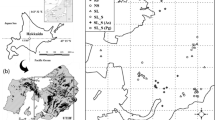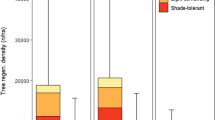Abstract
In a Metasequoia glyptostroboides coastal forest shelterbelt near Shanghai, China, we studied relationships between stand structure and wind shelter effect. We located 16 plots at intervals of 500 m along the shelterbelt and characterized both horizontal and vertical structure of each plot. Wind speed was measured within each plot and at different distances windward and leeward. We found that wind shelter effects were closely related to stand structure of the studied M. glyptostroboides shelterbelt. Stands with high basal area but intermediate crown index and intermediate proportion of large trees (LT) produced the best shelter effects, with significantly longer shelter distance (d70, shelter distance which the wind speed U does not exceed 70 % of U 0) and slightly lower minimum relative wind speed (U m /U 0). Simple structural indices that can be easily measured in the field were good predictors of the shelter effect. LT was the best predictor of d70, while basal area at ground level was the best predictor of U m/U 0. The relationships between stand structure and shelter effect provides a practical guideline to the design, construction and management of forest shelterbelts. In order to provide the best shelter effects, high basal area of >50 m2 ha−1 at ground level or >33 m2 ha−1 at breast height coupled with an intermediate LT value of about 60 % should be maintained for the studied M. glyptostroboides shelterbelt.




Similar content being viewed by others
References
Cleugh HA (1998) Effects of windbreaks on airflow, microclimates and crop yields. Agrofor Syst 41:55–84
Cornelis WM, Gabriels D (2005) Optimal windbreak design for wind-erosion control. J Arid Environ 61:315–332
Glenn NF, Spaete LP, Sankey TT, Derryberry DR, Hardegree SP, Mitchell JJ (2010) Errors in LiDAR-derived shrub height and crown area on sloped terrain. J Arid Environ 75:377–382
Kaitaniemi P (2008) How to derive biological information from the value of the normalization constant in allometric equations. PLoS One 3:e1932. doi:10.1371/journal.Pone.0001932
Lee KH, Ehsani R, Castle WS (2010) A laser scanning system for estimating wind velocity reduction through tree windbreaks. Comput Electron Agric 73:1–6
Mercer GN (2009) Modelling to determine the optimal porosity of shelterbelts for the capture of agricultural spray drift. Environ Model Softw 24:1349–1352
Miller DR, Lin JD, Lu ZN (1991) Some effects of surrounding forest canopy architecture on the wind field in small clearings. For Ecol Manag 45:79–91
Santiago JL, Martin F, Cuerva A, Bezdenejnykh N, Sanz-Andres A (2007) Experimental and numerical study of wind flow behind windbreaks. Atmos Environ 41:6406–6420
Sudmeyer RA, Scott PR (2002) Characterisation of a windbreak system on the south coast of western Australia. 1. Microclimate and wind erosion. Aust J Exp Agric 42:703–715
Torita H, Satou H (2007) Relationship between shelterbelt structure and mean wind reduction. Agric For Meteorol 145:186–194
Tuzet A, Wilson JD (2007) Measured winds about a thick hedge. Agric For Meteorol 145:195–205
Veblen TT, Donoso C, Schlegel FM, Escobar B (1981) Forest dynamics in south-central Chile. J Biogeogr 8:211–247
Vigiak O, Sterk G, Warren A, Hagen LJ (2003) Spatial modeling of wind speed around windbreaks. CATENA 52:273–288
Wang H, Takle ES (1996) On three-dimensionality of shelterbelt structure and its influences on shelter effects. Bound-Lay Meteorol 79:83–105
Wang H, Takle ES (1997) Model-simulated influences of shelterbelt shape on wind-sheltering efficiency. J Appl Meteorol 36:695–704
Wang ZX, Yu MK, Cheng XR, Zhu CL, Wang J, Zhang C (2010) Study on protection effect of coastal windbreak in Shanghai suburb. J Plant Resour Environ 19:85–88 (in Chinese with English abstract)
Zeng H, Garcia-Gonzalo J, Peltola H, Kellomaki S (2010) The effects of forest structure on the risk of wind damage at a landscape level in a boreal forest ecosystem. Ann For Sci 67:111–118
Zhou XH, Brandle JR, Mize CW, Takle ES (2004) Three-dimensional aerodynamic structure of a tree shelterbelt: definition characterization and working models. Agrofor Syst 63:133–147
Zhu JJ, Matsuzaki T, Gonda Y (2001) Wind profiles in a coastal forest of Japanese black pine (Pinus tbubbergii Parl.) with different thinning intensities. J For Res 6:287–296
Zhu JJ, Gonda Y, Matsuzaki T, Yamamoto M (2003a) Modeling relative wind speed by optical stratification porosity within the canopy of a coastal protective forest at different stem densities. Silva Fenn 37:189–204
Zhu JJ, Matsuzaki T, Gonda Y (2003b) Optical stratification porosity as a measure of vertical canopy structure in a Japanese coastal forest. For Ecol Manag 173:89–104
Acknowledgments
The project was supported by the National Project of Scientific and Technical Supporting Programs Funded by Ministry of Science and Technology of China (No. 2009BADB2B03), the Key Foundation of Science and Technology in Zhejiang Province (No. 2011C12016), and the Natural Science Foundation of Zhejiang Province (No. LY12C16008). We are grateful for all of the support mentioned above.
Author information
Authors and Affiliations
Corresponding author
Rights and permissions
About this article
Cite this article
Wu, T., Yu, M., Wang, G. et al. Effects of stand structure on wind speed reduction in a Metasequoia glyptostroboides shelterbelt. Agroforest Syst 87, 251–257 (2013). https://doi.org/10.1007/s10457-012-9540-6
Received:
Accepted:
Published:
Issue Date:
DOI: https://doi.org/10.1007/s10457-012-9540-6




